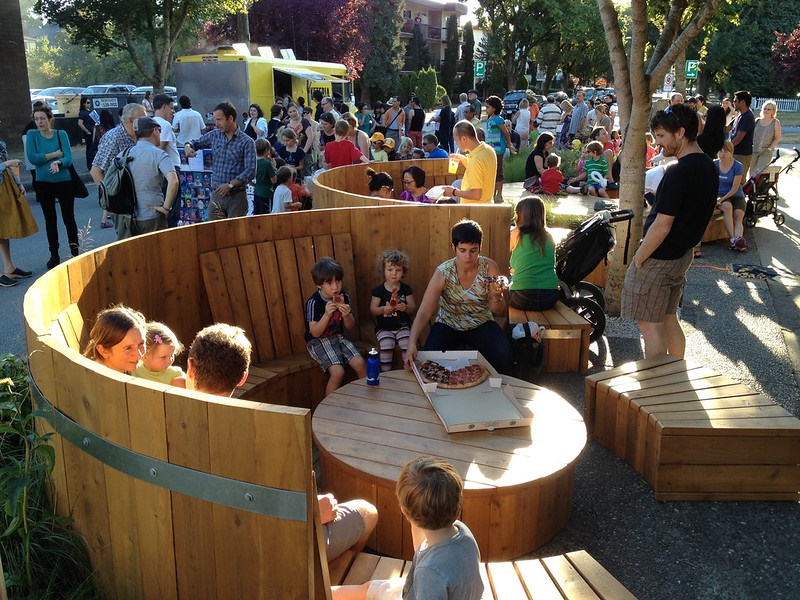Placemaking: toolkits & books
Read time: 3 minutes
This post is a companion to a previous post: Placemaking: trends & people. This post focuses on toolkits, methods, books and handbooks for effective placemaking in a range of contexts, from healthy streets and neighbourhood planning to risk management. Whether you self-identify as 'placemaker' or are just interested in people-friendly places, the following resources can provide some useful material and inspiration for your work as researcher, practitioner and/or volunteer.
The post is structured as follows:
- Toolkits (for the craft)
- Books (a small selection)
Toolkits & Repositories of Resources
Placemaking is a craft. The following tools and frameworks can be used for participatory diagnosis, design, management, evaluation and benchmarking of projects.
The Placemaking toolbox, by Placemaking Europe led by Rotterdam-based Stipo. It is an open source resource: help them grow the toolbox! The website hosts a large number of case studies around the world. They are continuously collecting tools from around the world.
The Place Standard tool helps to measure the quality of places. It assess 14 key aspects of places, covering both physical and social elements. Participants can score each element on a scale from 1-7. It was jointly developed by NHS Health Scotland, the Scottish government and Architecture & Design Scotland. See Architecture & Design Scotland for case studies and a full description of the tool.

The Place Standard tool, which allows users to assess the key qualities of places. Picture credit: Place Standard tool, Scottish government.
Similar to the Place Standard Tool, the Healthy Streets approach was deployed by Transport for London which seeks to integrate public space/place, aesthetics and sustainable mobility across the British capital. Among others, data collection and evaluation techniques include a bespoke on-street questionnaire survey, as well as a 'mystery shopper survey' to better understand Londoners' mobility patterns.
The Urban STEP participatory design method is leveraged by Stockholm-based Arken Arkitekter and landscape consultancy Ekologigruppen. The method's starting point is the specific typologies of places and towns/cities. Alongside participatory modelling, its key tool is the 'Value Rose' (värderosen), a 12-spoked spider diagram that comprises ecological, social, physical and economic sustainability elements. The specific components of the Value Rose can be adapted as per context.
Public realm ethnography. To improve places, you need to observe them. This article maps key practical and theoretical issues for immersive research in the public realm, which can support all other toolkits and resources provided here.
The Coordination Cluster is a disaster relief and management framework for collaboration between clusters of humanitarian organisations. It covers the key sectoral aspects of emergency management. As placemaking needs to become more resilient (by force or by choice), it seems opportune to include an emergency management tool here. The Cluster comprises disaster prevention, mitigation, preparedness, disaster response, recovery and reconstruction. It was first used after the 2005 earthquake in Pakistan. See also the comprehensive toolbox and information repository provided by OCHA (UN Office for the Coordination of Humanitarian Affairs).

The Cluster Approach for preventing and responding to emergencies. Picture credit: Humanitarian Response, United Nations Office for the Coordination of Humanitarian Affairs (OCHA).
Indicators
Some people claim that 'if you can't measure it, it doesn't exist'.
The Guide to the Healthy Streets Indicators (2017) adopts the Healthy Streets Approach™. It considers 10 different indicators that focus on mobility and street attractiveness. The guide was jointly produced by Transport for London and consultant Lucy Saunders, and is part of the Draft London Plan (2017) and the Mayor's Transport Strategy (2018).
Community Indicators Consortium provides resources for a wide range of indicators to measure and benchmark communities. The key idea behind community indicators is: you need indicators if you want to measure progress within and between different communities . Check out these 'happiness' indicators, for example.
Participatory design workshops
Participatory 3D modelling. In a development and environmental resource management context, Participatory 3D modelling is a very effective tool in engaging local communities in shaping their living and natural environment. This handbook is authored by Participatory GIS leading expert Giacomo Rambaldi (@iapd on twitter), and is available in English, Spanish, French, Portuguese and even Amharic.
Charrettes. A participatory method rather than a tool, charrettes are intensive group-based design workshops. The Whole Building Design Guide gives the full low-down on charrettes. See also the Handbook for Planning and Conducting Charrettes for High-Performance Projects for a (very) comprehensive manual, leveraged by the National Renewable Energy Laboratory of the US Department of Energy.
Books & articles
The number and diversity of placemaking resources is growing. Here is a small selection:
- Amazon's Goodreads lists 55 books that revolve around placemaking, which also includes New Urbanism, permaculture, healthy places, and more.
- How to turn a place around, by Kathy Madden (new 2020 edition).
- The Placemaker's Guide to Building Community, by Nabeel Hamdi (2010).
- The Great Neighborhood Book: A DIY Guide to Placemaking, by Jay Walljasper (2007)
- Cities for people (2010) and Life Between Buildings (2011 [1971]) by iconic architect Jan Gehl.
- The Social Life of Small Urban Spaces, by William H Whyte (1980)

Making public places great again: one initiative at a time. Picture credit: Hot Tub Parklet by Paul Krueger on Flickr, Attribution CC.
Share your favourite placemaking resources with:
When you subscribe to the blog, we will send you an e-mail when there are new updates on the site so you wouldn't miss them.


Comments 3
[…] ← Preparing to shine at the VIVA Placemaking: toolkits & books → […]
[…] academics, practitioners…. Cartoons, just like participatory games, citizen participation and placemaking techniques (among others) can all support systemic change. Humour and creativity can inspire steadfast efforts […]
[…] how placemaking can improve a place’s climate resilience, and crafted using with a range of useful toolkits. One can cite the increasingly popular Place Standard Tool (made in Scotland) and the Placemaking […]